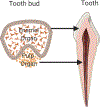Tooth Repair and Regeneration: Potential of Dental Stem Cells
- PMID: 33781688
- PMCID: PMC9907435
- DOI: 10.1016/j.molmed.2021.02.005
Tooth Repair and Regeneration: Potential of Dental Stem Cells
Abstract
Tooth defects are an extremely common health condition that affects millions of individuals. Currently used dental repair treatments include fillings for caries, endodontic treatment for pulp necrosis, and dental implants to replace missing teeth, all of which rely on the use of synthetic materials. By contrast, the fields of tissue engineering and regenerative medicine and dentistry (TERMD) use biologically based therapeutic strategies for vital tissue regeneration, and thus have the potential to regenerate living tissues. Methods to create bioengineered replacement teeth benefit from a detailed understanding of the molecular signaling networks regulating natural tooth development. We discuss how key signaling pathways regulating natural tooth development are being exploited for applications in TERMD approaches for vital tooth regeneration.
Keywords: dental epithelial–mesenchymal cell–cell interactions; dental stem cells; regenerative medicine and dentistry; spatiotemporal control; tissue engineering; tooth regeneration; tooth repair.
Copyright © 2021 Elsevier Ltd. All rights reserved.
Conflict of interest statement
Declaration of Interests The authors declare no competing interests.
Figures


References
-
- Ten Cate AR, Oral histology : development, structure, and function. 5th ed. 1998, St. Louis: Mosby. xi, 497 p.
-
- Forssell-Ahlberg K, Brannstrom M, and Edwall L, The diameter and number of dentinal tubules in rat, cat, dog and monkey. A comparative scanning electron microscopic study. Acta Odontol Scand, 1975. 33(5): p. 243–50. - PubMed
Publication types
MeSH terms
Grants and funding
LinkOut - more resources
Full Text Sources
Other Literature Sources

